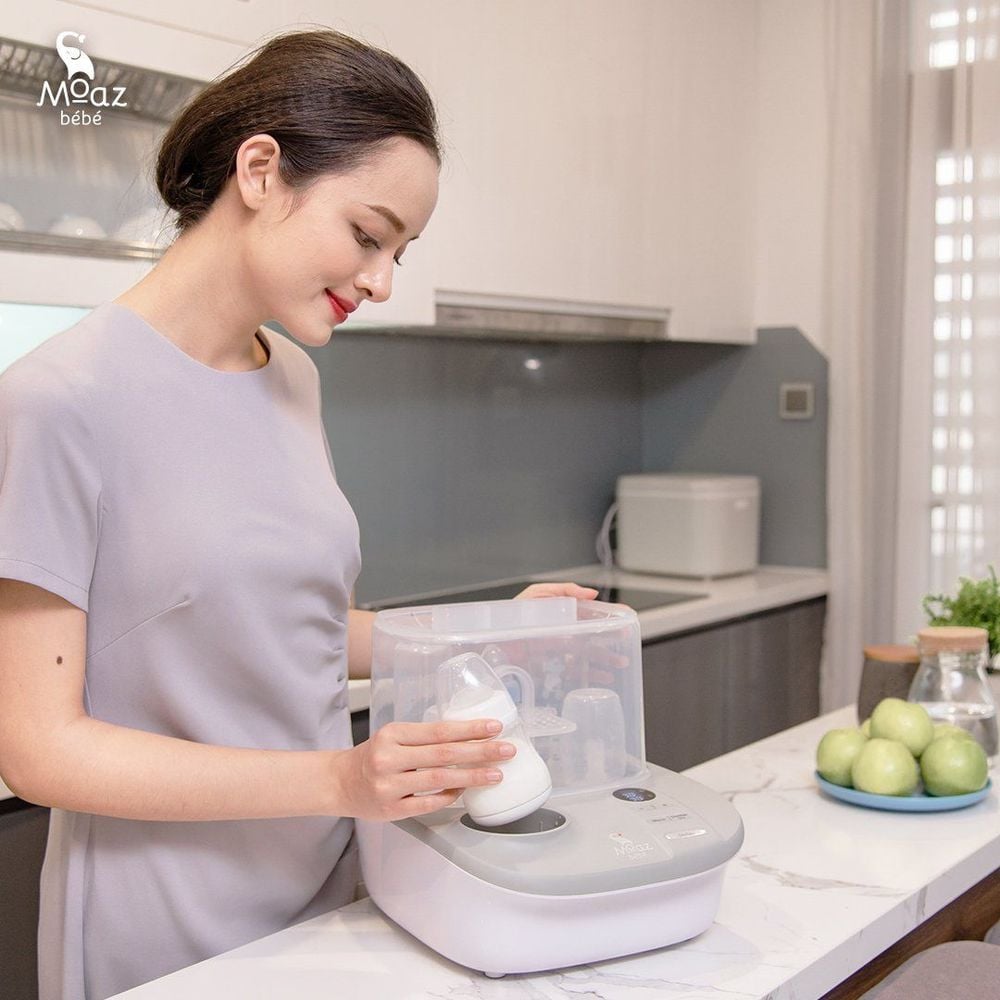This is an automatically translated article.
This article was professionally consulted by Dr. Nguyen Nhu Thu Truc - Obstetrician and Gynecologist - Department of Obstetrics and Gynecology - Vinmec Nha Trang International General Hospital.Breast milk is the best food for babies in the first 6 months of life. In addition to the essential nutrients in breast milk that help keep babies healthy and increase resistance, breastfeeding also brings many benefits to mothers such as: rapid weight loss, release of oxytocin hormone, and reduced risk of breast cancer. and ovarian cancer...
1. Nutritional composition of breast milk
Breast milk is full of nutrients, especially from 10 to 15 days after birth, so doctors advise mothers to breastfeed from birth. Breast milk has the following main components: Fats, proteins, carbohydrates, passive antibodies, vitamins and minerals, enzymes and hormones.Fats (lipids)
Fats are the most important and predominant component of breast milk. Fat in breast milk provides 50% of daily energy for babies. Fats in breast milk are mainly Triglycerides and long fatty acids: AA and DHA help the development of the baby's retina, brain, nervous tissues and immune system. MHO also makes a short fatty acid in breast milk that has the function of pushing waste and bacteria out of the baby's intestines, similar to the effect of fiber (there is no fiber in breast milk). Therefore, breastfed babies absolutely do not have constipation or diarrhea, even though they have many bowel movements 2 times a day or many times a day, their stools are still soft, yellow without lumps.
Fats are also solvents to help absorb some important vitamins.
Protein (Protein)
In addition to fat, protein is a component of breast milk that cannot be ignored. Protein provides amino-acids for the baby, helps in muscle and bone growth, creates antibodies, acts as a solvent for hormones, and creates necessary enzymes. Protein includes: WHEY protein and CASIEN protein.
WHEY protein: 60% (a-lactalbumin, lysozyne, lactoferrin, immunoglobulin ...). Besides the nutritional function, whey protein with the above ingredients has the function of protecting and eliminating excess substances, residues, toxins and foreign cells out of the body. Whey protein in breast milk in liquid form helps children digest and absorb easily in the intestines to help complete the intestinal mucosa, create antibodies ...
CASIEN protein: makes up 40% of milk, has the main function as nutritional protein, precipitate in the intestines in a soft form like tofu that is easily digested and absorbed. Disaccharide Lactose, also known as Lactose, is the main ingredient in breast milk, providing 40% of the energy needed for the baby's growth and development. Lactose and Oligosaccharide are considered the two most important and main carbohydrates of breast milk. Their main effect is to support the development of the brain, while helping children have a healthy intestinal system, good digestion and absorption of nutrients.

Antibodies (passive)
The composition of breast milk is the main factor that helps babies stay healthy and fight against pathogens from the outside environment. At each feeding, millions of live white blood cells from breast milk and immunoglobulins are introduced into the baby's body. When the baby is attacked by bacteria, these substances will play a role in protecting the baby from growing up healthy.
Vitamins and minerals
Breast milk is rich in iron, calcium and selenium, all of which are easily absorbed. They not only give children a strong skeleton and teeth, a healthy immune system, but also bring a lot of benefits to brain development.
Enzymes and hormones
Breast milk includes digestive enzymes lipase, amylase, hormones prolactin, thyroid, oxytocin that play a role in increasing intestinal health, balancing biochemical.
These enzymes and hormones have an effect on the taste of breast milk, when the mother changes the diet they will change. So they help your baby gradually get used to different foods in life.
Trắc nghiệm: Vì sao mẹ sinh mổ xong khó có sữa ngay?
Vì sao mẹ sinh mổ xong khó có sữa ngay là thắc mắc và lo lắng chung của nhiều sản phụ. Bài trắc nghiệm này sẽ giúp sản phụ giải đáp thắc mắc cũng như tìm hiểu được phương pháp gọi sữa về sau sinh mổ.The following content is prepared under supervision of Thạc sĩ, Bác sĩ y khoa, Tạ Quốc Bản , Sản phụ khoa , Khoa Sản phụ khoa - Bệnh viện Đa khoa Quốc tế Vinmec Phú Quốc
2. Benefits of breastfeeding
Breastfed babies have conditions for comprehensive development and organ system development:Brain - higher IQ (cholesterol and other fats in breast milk have the effect of supporting the development of nerve tissue) terrible). Eyes - better eyesight. Ears - fewer ear infections. Oral - breastfed babies for 1 year or more need less orthodontic treatment. Breastfeeding improves facial muscle development. The subtle changes in the taste of breast milk help your baby learn to get used to a variety of complementary foods. Respiratory system - are less prone to upper respiratory infections and if they do, usually milder. Children wheeze less, have fewer pneumonia and flu. Cardiovascular - lower heart rate. Breastfed babies may have lower cholesterol levels as adults. Digestive system - less diarrhea, less gastrointestinal infections. Exclusive breastfeeding for the first 6 months or more reduces the risk of food allergies. At the same time, it also reduces the risk of ulcerative colitis which also decreases as the child reaches adulthood. Immune system - breastfed babies respond better to immunizations. Breast milk helps children's immune systems mature better and reduces the risk of cancer in adulthood. Endocrine system - reduces the risk of diabetes. Kidneys - with a lower amount of salt and protein, breast milk reduces the burden on the kidneys. Urinary system - less infections Musculoskeletal - less prone to rheumatoid arthritis. Skin - less prone to atopic eczema. Growth - babies under 1 year old are slimmer and less likely to become obese later in life. Intestines - less constipation, less strong-smelling stools.

3. Why is it important to breastfeed exclusively for the first 6 months?
When babies are exclusively breastfed for the first 6 months, babies will be strengthened with antibodies, improve resistance, reduce the risk of skin diseases, asthma, obesity... Children develop a natural immune system by creating favorable conditions for beneficial bacteria in the intestinal tract to grow, helping to destroy harmful bacteria thereby reducing the risk of infection and disease... Breast milk has a higher IQ.The benefits of breastfeeding extend beyond weaning. Breast milk also has the effect of preventing cardiovascular metabolic diseases such as obesity, high blood pressure, high blood lipids and type 2 diabetes.
Besides, breastfeeding in the first months of life is a sacred moment. bring you and your baby closer together. This gives a motherly and spiritual bond to both you and your baby.
Also while breastfeeding, I feel very happy to see you healthy, you grow up every day and I know that I gave you the best that I could. In addition, exclusive breastfeeding in the first 6 months also brings many benefits to mothers such as weight loss after birth, fast uterus recovery, and reduced postpartum bleeding. It also delays ovulation and menstrual cycles. Breastfeeding reduces the risk of breast and ovarian cancer and may reduce the risk of osteoporosis at menopause.
When the mother has to go back to work or school, she can express milk to reserve, both to feed the baby while she is away, and at the same time to help with the blockage of milk.
Breast milk after expressing, if kept at a normal temperature of about 26°C, it is only safe to use for 4-6 hours, about 22°C, it can be used for 6-8 hours. Breast milk stored in the regular compartment of the refrigerator can be used within 24 hours.
If stored in the freezer, this amount of milk can be used gradually in about two weeks. When stored in a specialized freezer at -18°C, breast milk can be kept for up to six months.
Read more: Expiry date of breast milk
After being refrigerated, mothers can warm up breastfeeding using hot water or specialized devices such as Moaz Bébé bottle warmer, sterilizer and dryer. MB - 005 . With a safe and clean closed process, the machine has a function of warming milk to set the desired temperature, only 15-20 minutes to complete the feeding for the baby. Besides, the machine also has a modern sterilization and drying function with a spacious sterilization chamber that can hold 5-6 bottles and teats at the same time. The machine is designed to fit all wide-neck bottles and can sterilize baby's bowls and spoons. The milk heating and sterilization functions work independently of each other, with an accompanying alarm when each process is completed.

Please dial HOTLINE for more information or register for an appointment HERE. Download MyVinmec app to make appointments faster and to manage your bookings easily.















